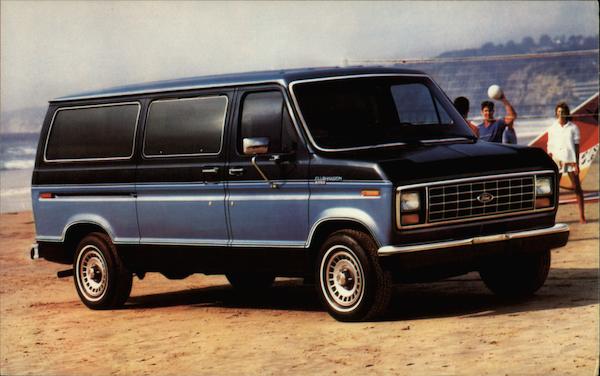
The undisputed market leader in the full-size passenger van segment is the Ford Club Wagon, the passenger version of the Econoline van. The Club Wagon, until this model year the only full-size passenger van with body-on-frame construction, has always been head-and-shoulders better than the Chevrolet and Dodge full-size vans, which are built with unitbody construction techniques and simply aren't as stiff or as quiet as the frame-built Ford. The 1996 Chevrolet G-van (see page 112) has switched over to body-on-frame construction and should finally give the Ford some competition in the marketplace.


 The Club Wagon's current family of engines, the 4.9-liter inline six, the 5.0, 5.7- and 7.5-liter overhead valve V-8s, and the 7.3-liter Power Stroke diesel, is the widest in the industry, adding to the already amazing flexibility offered to the customer by the Club Wagon Chateau. All but the Power Stroke will be gone next year, though, as a new generation of more expensive Ford engines, a 4.2-liter V-6, 4.6- and 5.4-liter V-8s and a 6.8-liter V-10, take over.
The Club Wagon's current family of engines, the 4.9-liter inline six, the 5.0, 5.7- and 7.5-liter overhead valve V-8s, and the 7.3-liter Power Stroke diesel, is the widest in the industry, adding to the already amazing flexibility offered to the customer by the Club Wagon Chateau. All but the Power Stroke will be gone next year, though, as a new generation of more expensive Ford engines, a 4.2-liter V-6, 4.6- and 5.4-liter V-8s and a 6.8-liter V-10, take over.
Our enthusiasm for the Ford Club Wagon Chateau is massive. We've driven perhaps 35 examples over the past 20 years, a dozen or so since its latest tune-up in 1992. It's simply smoother, quieter, and better built than its two prime competitors, with a much more integrated feel. The bucket seats are comfortable and supportive enough for thousand-mile days. Its monster 138-inch wheelbase provides a luxurious road ride, even though the front beam-and-coil and rear leaf spring suspension sound primitive. The instrument panel is straightforward, with excellent graphic presentation (no tach, though), and the engine cover has a truly large and flexible storage space built into it for all those family trip items. There are still a few visible screw heads, and some body color paint can be seen on the interior, but overall, this is a quality piece.

Like the Chevy and Dodge, the Ford van is available in a number of seating configurations for seven, eight or 12 persons (SuperVan version, 20 inches longer, will seat 15), with a six, three V-8s, or a diesel engine for power, sliding or conventional side door, and either a single or double rear doors, and three basic weight ratings, depending on what your family's wants, needs and likes are. Disc/drum ABS brakes are standard.

With all the modern front-drive minivans available today from The Big Three and All The Rest, why are there still three big passenger vans? Lots of reasons, most of them having to do with ultimate roominess, the trailer-towing capabilities of rear-wheel-drive vans, and the availability of big V-8 engines for pulling Mom, the kids, the dog, all the camping gear, as well as the boat, motor and trailer. For some families, a minivan just doesn't cut it.
Our test Club Wagon was a luxury Chateau version with the 5.0-liter EFI V-8 engine, 4-speed automatic overdrive transmission, sliding side door, chrome rear step bumper, P235/75R-16 tires, front bucket seats, twin swiveling captain's chairs in the second row and a conventional three-passenger third seat, making for a total capacity of seven persons, plus a truly huge storage well behind the third seat. The base price of $23,915 swelled to $27,648 all in, including delivery.
No comments:
Post a Comment